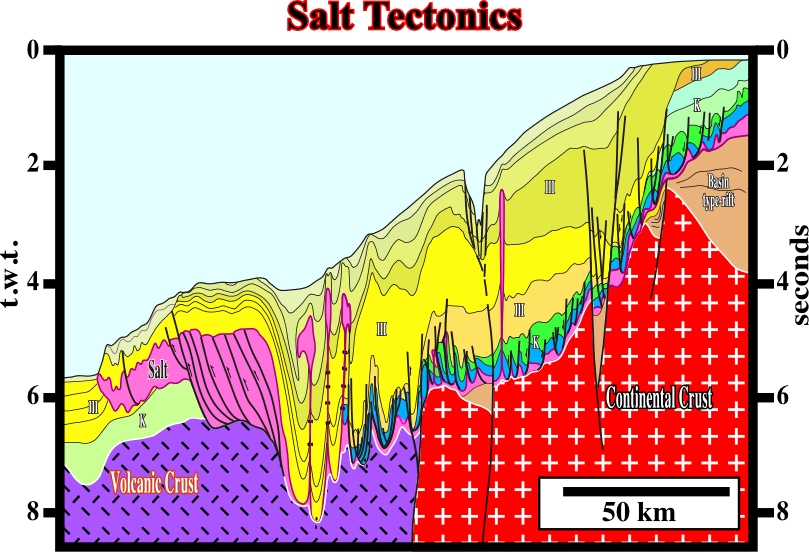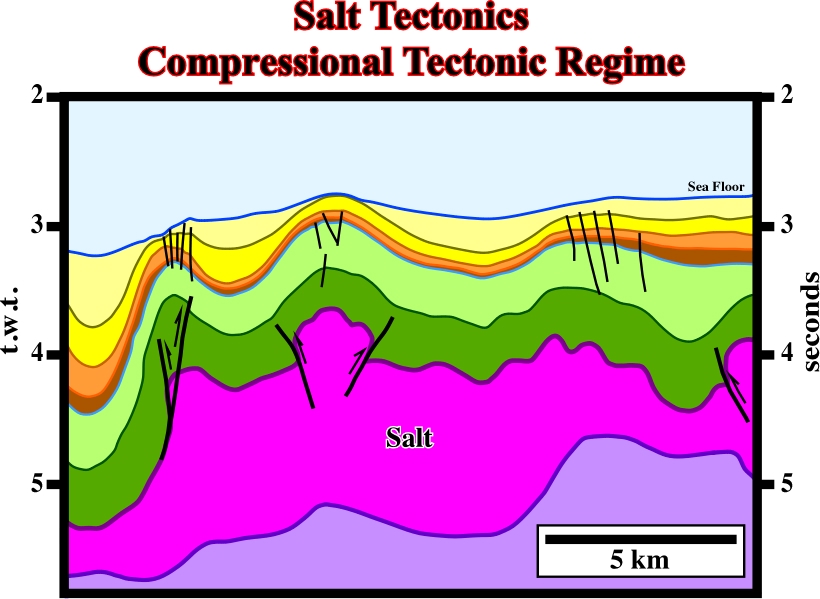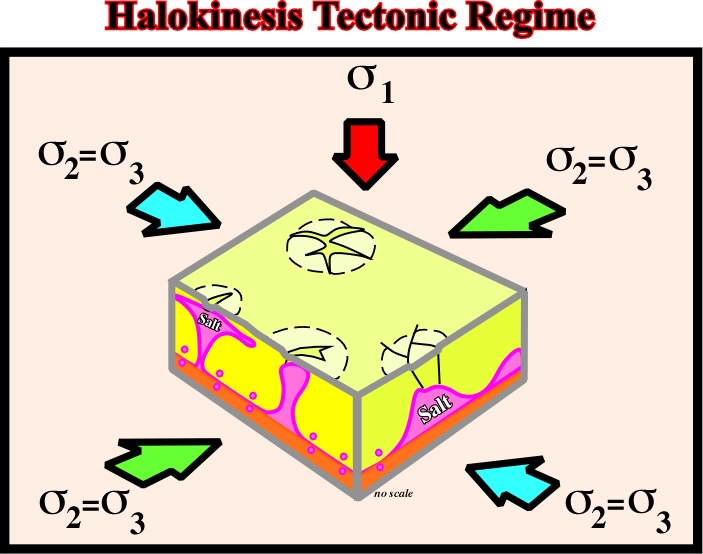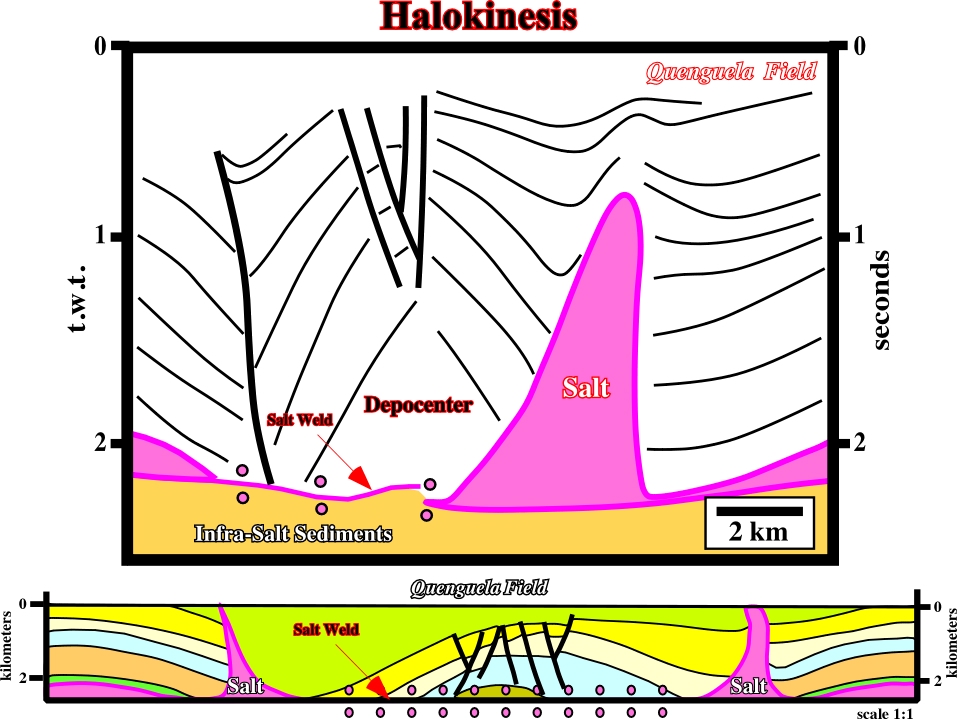

Salt Tectonics (fig. 1) has been defined as any tectonic deformation of a sedimentary package involving salt or other evaporites as a mobile substratum or mobile layer. In this sense, salt tectonics is not a synonym of halokinesis, which labels a sedimentary deformation powered entirely by gravity, i.e., by buoyancy, in absence of significant tectonic stress (σt).

Fig. 1- This composite time profile of the Northern Offshore Angola (South Congo Basin) illustrates what we intend to convey by salt tectonics. The Atlantic-type divergent margin, in which an evaporitic layer (Loeme Salt) was deposited, has undergone different tectonic regimes. The regional tectonic regime was extensional and characterized by a maximum effective stress (σ1) vertical, a medium effective stress (σ2) horizontal striking, roughly, NNE-SSW, and a minimum effective stress (σ3) horizontal and orthogonal to σ2. In addition, as depicted above, the deformation of the sedimentary package (salt layer included), strongly, suggests several local compressional and extensional tectonic regimes took place. Some are due to reactivation of fracture zones, other associated with “ridge pushing forces”, others are induced by readjustment of the lithospheric plates and others related with halokinesis.
A stratigraphic column, in which a salt layer (or an evaporitic layer) is inter-bedded with other rocks, can be deformed in different ways. The deformation depends on whether the basement is involved in the deformation and upon the effective stresses ellipsoid, i.e., the tectonic regime, which can change spatially and temporally (fig.1). A salt layer can be lengthened, or shortened, or both. It depends upon the geological history of the area (fig. 2). In addition, in absence of an important tectonic stress (σt ), the salt layer can flow by itself following the basic principles of halokinesis. When the basement is involved, the salt is deformed along with the other rocks, which they are lengthened, when σ1 is vertical and shortened when σ1 is horizontal.

Fig. 2- This tentative interpretation of an Angola offshore seismic line, shot on a quite deep water, illustrates that a salt layer, independent of its thickness and its previous history (autochthonous or allochthonous), can be lengthened or shortened as any other rock following the basic principles of tectonics. In this particular example, taking into account that the profile is in time and not in depth, it is highly probable that the infra-salt rocks (probably volcanic crust, i.e., lava-flows, SDRs) was involved in deformation. Actually, in South Atlantic Margins, and particularly in African margins, an Upper Miocene - Pliocene compressional tectonic regime, induced by ridge-push stresses or a reactivation of the lithospheric plates, shortened the sedimentary pile, as well as, the volcanic crust (sub-aerial or oceanic crust). The faults, located on the apexes of the anticlines, are not normal faults. They are contemporaneous of the shortening. They are associated with the same tectonic regime that created the anticline and syncline structures. In fact, they are small strike slip faults that elongate the anticline structures along their axes (σ2). Such interpretation is corroborated by time contour maps of the Upper Cretaceous horizon (light green) and by time, or depth, slice interpretation.
Whenever the basement is not involved in the deformation, generally, there is a tectonic disharmony between the overburden and the sub-salt strata:
- The overburden is either shortened or lengthened, while the sub-salt strata are undeformed or slightly deformed.
- Locally, in the absence of significant tectonic stresses, halokinesis extends (lengthen) the overburden.
In absence of significant tectonic stress (σt = 0), i.e., in a tectonic regime characterized by σ1 vertical and σ2= σ3 (fig. 3), salt can flow laterally and vertical creating a compensatory subsidence, which gives accommodation (space available) for the overburden sedimentation. Such a local and differential accommodation induces significant lateral thickness variations in the syn-kinematic layers of the overburden, which are one of the main characteristics of the halokinesis, as illustrated by Quenguela depocenter (fig. 4).

Fig. 3- The tectonic regime favouring halokinesis is characterized by an effective stress ellipsoid with σ1 vertical and σ2 and σ3 horizontal. In addition, σ2 is equal to σ3, which explains the normal radial faulting so diagnostic of halokinesis. As we will see later (Table I), such a tectonic regime implies that : (i) the basement is not involved in deformation and (ii) a nil tectonic stress (σt = 0).
Salt and other evaporites result from extensive or total evaporation of the solvent of saline solution. However, it is important to realize that the origin of the brine can be quite different and it can be enriched in certain mineral by hydrothermal alteration. The most suitable host is basalt, hydrothermally altered to spilite greenstones. In fact:
(i) Chloritization absorbs Mg from the brine ;
(ii) Albitization releases abundant Ca into the brine, which combines with any S04 present to precipitate at surface and
(iii) Brine lakes remain enriched in Ca.
Others host rocks for hydrothermal alteration are also possible : a) Arkose containing plagioclase; b) Red-beds containing Ca-Smectites; c) Limestones.

Fig. 4- The trapping in Quenquela oil field, in the Angola onshore (Kwanza geographic basin), is associated to an antiform created by halokinesis. The cross-sections (in time and in depth), clearly, illustrated the salt induced tectonic disharmony at the bottom of the cover (salt + overburden). The infra-salt sediments are undeformed, while the salt and the overburden are quite deformed (extended). The salt and fault welds, induced by salt flowage, are recognized, easily, as well as, the large antiform (extensional structure) and the depocenters in the overburden. The normal faults of the top of the antiform are coeval of the deformation.
If you have a problem to with certain geological terms used in this introduction, don't be afraid they are explained during this short course.
to continue press
next